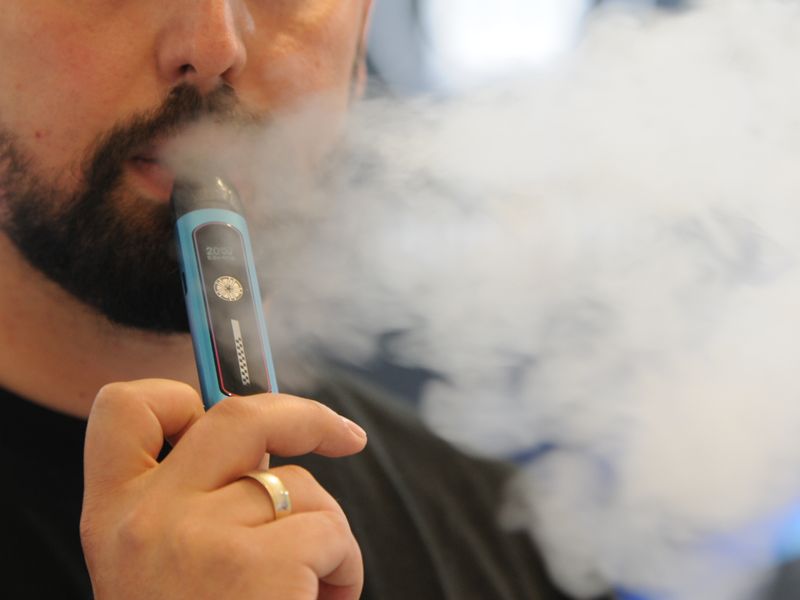 Have the article read by OpenAI (Beta). Please note that AI translations may take some time to process.
Have the article read by OpenAI (Beta). Please note that AI translations may take some time to process.In early December, a majority of European Union health ministers signalled their support for extending smoke-free areas in a bid to reduce cancer deaths. The recommendation passed with all countries voting in favour apart from Germany and Greece, which abstained, underscoring some political divisions on the issue.
The aim of the new guidelines is to restrict smoking in public areas where children or other vulnerable people gather outdoors, like playgrounds, amusement parks, public swimming pools, restaurant terraces and public transport.
The recommendations also target emerging tobacco products, like electronic cigarettes and heated tobacco products, to deter young people from smoking. Reducing exposure to second-hand smoke and aerosols would mean better protection for non-smokers, an EU press release said.
A week prior, the European Parliament voted against a resolution on the same subject, after lawmakers on the right passed amendments to differentiate between traditional tobacco products and electronic devices. The parliamentary resolution would have only had symbolic value.
The European Commission proposed the overhaul of the current guidelines from 2009 as every year around 700,000 people in the EU lose their lives due to tobacco consumption, the new EU Health Commissioner Olivér Várhelyi said ahead of the vote. “It is the largest avoidable health risk in the EU,” Várhelyi stressed.
Tobacco use is estimated to kill more than eight million people globally each year, including about 1.3 million non-smokers who are exposed to second-hand smoke, World Health Organization (WHO) statistics show.
According to EU figures, a quarter of cancer deaths in the EU, Iceland and Norway can be attributed to smoking, making tobacco the leading cancer risk. Health policy however is a competence of EU member states, meaning that the new recommendations are non-binding and capitals are free to implement them or not.
As part of the European “Beat Cancer” plan, the European Commission set out to create a “tobacco-free generation” in which less than 5% of the EU population uses tobacco by 2040. In addition, the EU has allocated significant funding to support Member States in implementing these measures.
Through the EU4Health programme, a 16 million Euro grant has been awarded to promote anti-smoking policies, while the Horizon programme has allocated 80 million Euro for research into tobacco control and addiction prevention.
Decline in tobacco use but growing success of e-cigarettes
Tobacco consumption in the EU has declined in recent decades, but the pace varies depending on the country.
According to a recent Eurobarometer survey on Europeans’ attitudes towards tobacco and related products, nearly a quarter of the EU’s population (24%) smokes – a drop of one percentage point since a 2020 survey – but the proportions vary widely across the countries. Bulgaria (37%), Greece (36%) and Croatia (35%) rank highest while Sweden (8%) and the Netherlands (11%) rank lowest.
Despite the growing success of e-cigarettes, consumed especially by young people aged 15 to 39, boxed cigarettes remain the most popular choice. Average consumption also remains the same compared to 2020 figures, with 14 cigarettes smoked per day.
“Given the extensive marketing of vapes as healthier alternatives to conventional smoking, they have gained popularity among people trying to quit smoking,” said Josef Hamoud of Germany’s University Medical Center Goettingen, lead author of a study on the dual use of vaping and smoking. “There is still a lot we don’t know about the long-term health effects of vaping,” he explained.
Fearing young people taking up vaping en masse, some countries have moved to ban e-cigarettes, or at least prohibiting disposable versions or kid-friendly flavours.
In the Netherlands, in early November a court upheld the government’s ban on non-tobacco flavourings for electronic cigarettes on the grounds that they encourage young people to smoke. The court in The Hague ruled against tobacco giant British American Tobacco. The flavour ban has been in force since January 1, 2024.
Given the mass deaths caused by tobacco, many medical researchers have called for vaping to remain legal as a tool for quitting smoking – while doing everything possible to stop young people from taking up either habit.

Stark differences across the EU when it comes to combating smoking
Data from over 40 countries collected by the Smoke Free Partnership, a European coalition of NGOs fighting for tobacco control, show that in 2022 half of the countries on the European continent had “good” or “very good” measures in place to protect civilians from second-hand smoke, for example through bans on smoking in certain places.
Some European countries have banned smoking in the vicinity of schools, outside workplaces or in sports stadiums, but Sweden is the only European country to have completely banned smoking on restaurant and bar terraces.
In Sweden, the number of daily smokers is low which is mostly due to the Swedish tradition of “snus” – a mashed tobacco product that is placed under the lip, considered less dangerous than smoking as it only harms the user. According to the latest figures, 22% of Swedish men and 10% of women are using snus daily.
Since 2014 tobacco-free snus – with added nicotine – is available and has become extremely popular, especially among young people, as it’s often flavoured with anything from lemon to licorice. Not officially a tobacco product, it is not banned by the EU as such even though some national bans exist in this context. Big international tobacco companies which own many of the Swedish producers fight hard for the product not to be declared illegal outside Sweden.
Low taxes, high numbers of smokers?
Taxes on tobacco products also vary between member countries, which directly influences the price and therefore consumption.
For example, in Ireland and the United Kingdom – an EU member until 2020 – taxes are very high, which has contributed to a significant reduction in the smoking rate, while in other countries, such as Poland, taxes are lower and consumption remains high.
Bulgaria ranks among the top ten countries globally in terms of smoking and has the cheapest price of cigarettes in the EU, said Dimitar Sabev from the Economic Research Institute at the Bulgarian Academy of Sciences when presenting a recent study carried out in cooperation with the Vienna Institute for International Economic Studies on behalf of the Smoke-Free Life Coalition Bulgaria.
The study supervisor further said that the price of cigarettes should be taken into account. “Our simulations have shown that smoking in Bulgaria as a percentage of the population will continue to increase if the current model of cigarette taxation is maintained,” the expert noted.
According to Pavel Antonov of BlueLink, a civil action network, and chairman of the Board of Directors of the Smoke-Free Life Coalition Bulgaria association, the caretaker finance minister “included raising excise duties in the plan he proposed”.
Slovenia is already following many of the EU recommendations on reducing exposure to second-hand smoke and aerosols, said Health Minister Valentina Prevolnik Rupel. Stricter rules will come into force next year such as a ban on flavoured e-cigarettes and heated tobacco products as well as the closure of smoking rooms in enclosed public and workplaces by the end of 2025.
The National Institute of Public Health estimates that a substantial increase in the price of tobacco and related products would also contribute to reducing smoking, as the financial reason is the most important factor in the decision to quit, alongside health concerns.
In Croatia, a new law is in the process of being passed that adds heated tobacco products to the existing ban on smoking in closed spaces. The new law also bans smoking outdoors within 20 metres of the entrance to a health or educational institution.
So far, there are no plans to extend the smoking ban to other open public spaces. A ban on smoking on cafe terraces would likely face great resistance, both from restaurateurs and their guests. Going for a coffee is one of the most cherished social customs which for many Croatians is unthinkable without a cigarette. Despite various anti-smoking campaigns and increased taxes on tobacco products, smoking remains a popular habit among the Croatian population.
In Romania, where an average of 34% of the population smokes, smoking is forbidden in all enclosed public spaces, public transport and playgrounds. By law, smoking of any kind by students in educational institutions is prohibited as well as selling smoking products to individuals under the age of 18.
According to the ‘Youth Risk Behavior Surveillance System (YRBSS) 2022’ study, 40% of high school students in Romania have smoked at least one cigarette in their lifetime.
Outside of the EU
Bosnia and Herzegovina: Starting from December 13, the Federation of Bosnia and Herzegovina – one of BiH’s two entities – is implementing strict bans on smoking in enclosed public spaces. From January 2025, cigarette and tobacco prices will rise due to increased excise taxes, as part of a strategy to reduce tobacco consumption through financial pressure. In contrast, in the Republika Srpska entity smoking is permitted in most venues, although regulatory changes are occasionally discussed.
Albania increased the excise duty on tobacco in January 2023. In a bid to further improve health protection from tobacco products, the Albanian Commission for European Affairs in summer proposed changes to an existing anti-tobacco law. It aims to toughen the penalties for those who sell or offer tobacco to those under the age of 18 as well as prohibiting the sale of electronic cigarettes, shishas, hookahs and other products to this group.
This article is published twice a week. The content is based on news by agencies participating in the enr.
